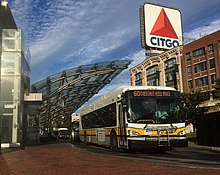Kenmore station
The station opened on October 23, 1932 as a one-station extension of the Boylston Street subway to relieve congestion in the square.
The Kenmore Loop connects the outer tracks, allowing inbound C and D trains to reverse direction without entering the main subway.
As the last station in the subway before it splits into surface lines, Kenmore is the terminal for MBTA bus routes 8, 19, 57, 60, and 65.
Streetcar passengers would make a cross-platform transfer to subway trains, similar to the then-recently-opened Ashmont station.
The streetcar tracks were placed on a wooden structure in the station and at the surface incline pending the future tunnel extension.
[15][16] Buses originally stopped at the curb, which required them to cut across multiple lanes of traffic to loop from inbound to outbound.
In early 1939, the Chamber of Commerce proposed a busway in the center of the square, with direct access to the station mezzanine below.
[28][29] The station was closed for two months in 1996, after the Muddy River overflowed its banks, completely submerging the platform and some of the mezzanine.
[35] Separately, the south entrance to the station was moved inside the Boston University-funded Hotel Commonwealth during its 2002-03 construction.
[39][34]: 31 The project also involved streetscape improvements with trees and brick sidewalks, intended to make Kenmore Square resemble Beacon Hill and the Back Bay as a break from its rough reputation.
[39] Previously undocumented utilities delayed excavation, and keeping the station open during construction presented difficulties.
[34]: 8, 30 Art panels featuring Red Sox players on station signs were unveiled at a ribbon-cutting ceremony on April 22, 2010.



